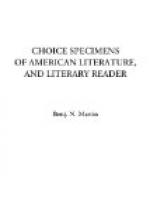... It has sometimes been suggested that the superiority of the Greeks in delineating the figure, arose from the familiarity with it which they acquired from their frequent opportunities of viewing it nude,—on account of their usages, costumes, climate, &c. This is too superficial an account of that vital faculty of skill and knowledge upon this subject, which was a part of the inherent capacity of the Greek.... The outflow and characteristic exercise of Grecian inspiration in sculpture, was in the representation of their mythology, which included heroes, or deified men, as well as gods of the first rank. Later, it extended to winners at the public games, athletes, runners, boxers;—but this class of persons partook, in the national feeling, of a heroic or half-divine superiority. A particular type of form, highly ideal, became appropriate to them, as to the heroes, and to each of the gods. It may be added, that a capacity thus derived from religious impressibility, extended to a great number of natural forms, which were to the Greeks measurably objects of a divine regard. Many animals as connected with the gods, or with sacrifices, were sacred beings to them, and became subjects of their surpassing gift in sculpture. In general, nature,—the visible, the sensible, the actual, was to the Hellenic soul, Religion; as inward and reflective emotions were and are, to the modern European.
[Footnote 55: A young writer of great cultivation and of uncommon promise. His premature death occurred while on a tour in Europe. A native of Philadelphia.]
* * * * *
=_Henry David Thoreau, 1817-1862._= (Manual, p. 532.)
From “Autumnal Tints.”
=_231._= DESCRIPTION OF “POKE” OR GARGET, (Phytolacca Decandra.)
Some which stand under our cliffs quite dazzle me with their purple stems now, and early in September. They are as interesting to me as most flowers, and one of the most important fruits of our autumn. Every part is flower, (or fruit,) such is its superfluity of color,—stem, branch, peduncle, pedicel, petiole, and even the at length yellowish purple-veined leaves. Its cylindrical racemes of berries of various hues, from green to dark purple, six or seven inches long, are gracefully drooping on all sides, offering repasts to the birds; and even the sepals from which the birds have picked the berries are a brilliant lake-red, with crimson, flame-like reflections, equal to anything of the kind,—all on fire with ripeness. Hence the lacca, from lac, lake. There are at the same time flower-buds, flowers, green berries, dark purple or ripe ones, and these flower-like sepals, all on the same plant.




